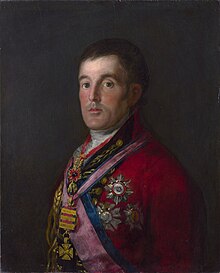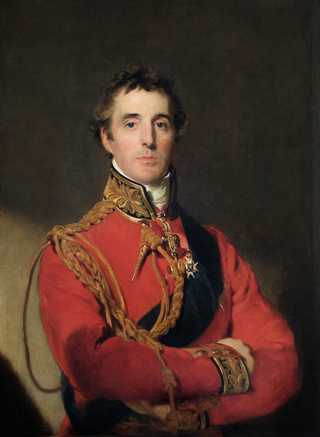
Field Marshal Arthur Wellesley, 1st Duke of Wellington, was a British statesman, soldier, and Tory politician who was one of the leading military and political figures of 19th-century Britain, serving twice as prime minister of the United Kingdom. He is among the commanders who won and ended the Napoleonic Wars when the Seventh Coalition defeated Napoleon at the Battle of Waterloo in 1815.

Duke of Wellington is a title in the Peerage of the United Kingdom. The name derived from Wellington in Somerset. The title was created in 1814 for Arthur Wellesley, 1st Marquess of Wellington, the Anglo-Irish military commander who is best known for leading the decisive victory with Field Marshal von Blücher over Napoleon's forces at Waterloo in Brabant. Wellesley later served twice as British prime minister.

Apsley House is the London townhouse of the Dukes of Wellington. It stands alone at Hyde Park Corner, on the south-east corner of Hyde Park, facing towards the large traffic roundabout in the centre of which stands the Wellington Arch. It is a Grade I listed building.

The Military Gallery is a gallery of the Winter Palace in Saint Petersburg, Russia. The gallery is a setting for 332 portraits of generals who took part in the Patriotic War of 1812. The portraits were painted by George Dawe and his Russian assistants Alexander Polyakov (1801–1835), a serf, and Wilhelm August Golicke.
Kempton Cannon Bunton was a disabled British pensioner and unemployed bus driver who confessed to stealing Francisco Goya's painting Portrait of the Duke of Wellington from the National Gallery in London in 1961. The theft of the painting was the subject of the October 2015 BBC Radio 4 drama Kempton and the Duke, and the 2020 film The Duke.
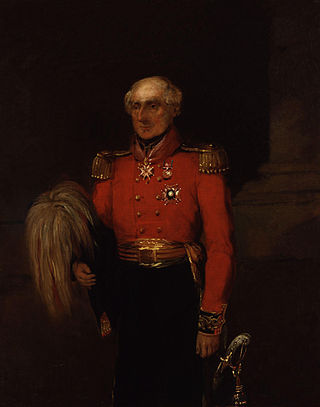
Lieutenant-General Sir Colin Campbell was a British Army officer and colonial governor.
4 William Salter was an English portrait painter of the 19th century. His best known work was a painting of 83 people at a banquet in 1836 organised by the Duke of Wellington to celebrate their victory at the Battle of Waterloo. The painting is called The Waterloo Banquet 1836 and today is at Apsley House.

The Venetian painter Titian and his workshop made at least six versions of the same composition showing Danaë, painted between about 1544 and the 1560s. The scene is based on the mythological princess Danaë, as – very briefly – recounted by the Roman poet Ovid, and at greater length by Boccaccio. She was isolated in a bronze tower following a prophecy that her firstborn would eventually kill her father. Although aware of the consequences, Danaë was seduced and became pregnant by Zeus, who, inflamed by lust, descended from Mount Olympus to seduce her in the form of a shower of gold.

Equestrian Portrait of Charles V is an oil-on-canvas painting by the Italian Renaissance artist Titian. Created between April and September 1548 while Titian was at the imperial court of Augsburg, it is a tribute to Charles V, Holy Roman Emperor, following his victory in the April 1547 Battle of Mühlberg against the Protestant armies.
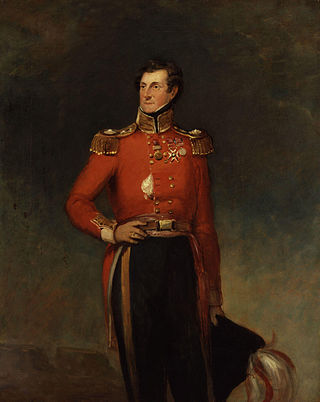
Colonel Sempronius Stretton (1781–1842) was a British Army officer who served in numerous campaigns including the Battle of Waterloo. He is also known for his sketches that recorded early Canadian life.
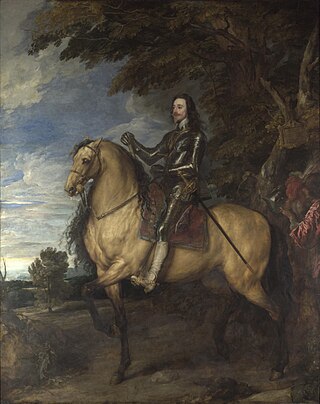
The Equestrian Portrait of Charles I is a large oil painting on canvas by Anthony van Dyck, showing Charles I on horseback. Charles I had become King of England, Scotland and Ireland in 1625 on the death of his father James I, and Van Dyck became Charles's Principal Painter in Ordinary in 1632.

The Chelsea Pensioners reading the Waterloo Dispatch, originally entitled Chelsea Pensioners Receiving the London Gazette Extraordinary of Thursday, June 22, 1815, Announcing the Battle of Waterloo, is an oil painting by David Wilkie, commissioned by Arthur Wellesley, 1st Duke of Wellington in August 1816.
The Wellington Collection is a large art and militaria collection housed at Apsley House in London. It mainly consists of paintings, including 83 formerly in the Spanish royal collection, given to Arthur Wellesley, 1st Duke of Wellington, who was Prime Minister as well as the general commanding the British forces to victory in the Napoleonic Wars. It also includes his collection of furniture, sculpture, porcelain, the silver centrepiece made for him in Portugal around 1815, and many other artworks and memorabilia relating to his career.

The Duke is a 2020 British comedy film directed by Roger Michell, with a screenplay by Richard Bean and Clive Coleman. Dealing with the 1961 theft of the Portrait of the Duke of Wellington, the film stars Jim Broadbent, Helen Mirren, Fionn Whitehead, Anna Maxwell Martin and Matthew Goode. It was Michell's penultimate film before his death on 22 September 2021.

The Spanish royal collection of art was almost entirely built up by the monarchs of the Habsburg family who ruled Spain from 1516 to 1700, and then the Bourbons. They included a number of kings with a serious interest in the arts, who were patrons of a series of major artists: Charles V and Philip II were patrons of Titian, Philip IV appointed Velázquez as court painter, and Goya had a similar role at the court of Charles IV.

Arthur Wellesley, 1st Duke of Wellington, was an Anglo-Irish soldier and Tory statesman who was one of the leading military and political figures of 19th-century Britain, commanding the British Army during the Napoleonic Wars and serving twice as prime minister. He has frequently been depicted in various cultural media.

The Portrait of the Duke of Wellington is a portrait by the English artist Thomas Lawrence of the Anglo-Irish soldier and politician the Duke of Wellington. It was begun in early 1815 following Wellington's success in the Peninsular War and shortly before his victory over Napoleon at the Battle of Waterloo and the subsequent allied occupation of France under Wellington's command. It is now in the collection of Apsley House, the Duke's London residence. Wellington is shown in military uniform displaying various honours including the Order of the Garter, the Order of the Golden Fleece and the Order of the Bath. He has been described as "impassive and aloof" in the painting. Lawrence's depiction of Wellington was used on the British Five Pound note between 1971 and 1991.
